How Buster
|
|
People argue endlessly that Buster influenced film comedy.
In my opinion, he did the best film comedy of all, but I don’t see any evidence that he influenced any other comedies.
Yes, occasionally a comic will wear a flat hat or will use CGI to have a wall fall down,
but those are mere momentary homages.
Did Buster change the direction of cinema comedy?
No, he didn’t, and he couldn’t.
Nothing that anybody ever did even remotely resembles what Buster did.
Buster’s imagination simply did not match anybody else’s.
What Buster did influence, though, and he influenced it mightily, was film distribution.
Yet he did so unwittingly, and he surely never even realized what he had accomplished.
|
|
Prior to 1962, there had been
a few reissues of silent features.
Several silents were converted to sound right at the time cinemas were installing sound.
They were
|
|
Then I know of two oddballs.
First there was The Birth of a Nation, a
1915 release that hit the screens again, highly abridged, in December 1930.
Next came Way down East, a 1920 movie reissued in February 1931, with an orchestral score by Louis Silvers,
surely similar to the original, on which he had worked a decade earlier.
These latter two films were not major releases, but were made available for individual bookings.
I doubt that there was even a poster
for the American reissue of Way down East.
|
|
Epoch’s
abridgment of The Birth of a Nation,
with Louis Gottschalk’s rearrangement of Joseph Carl Breil’s 1915 score,
appeared on
Tuesday, 2 December 1930,
and quietly
knocked about here and there for more than half a century (
|
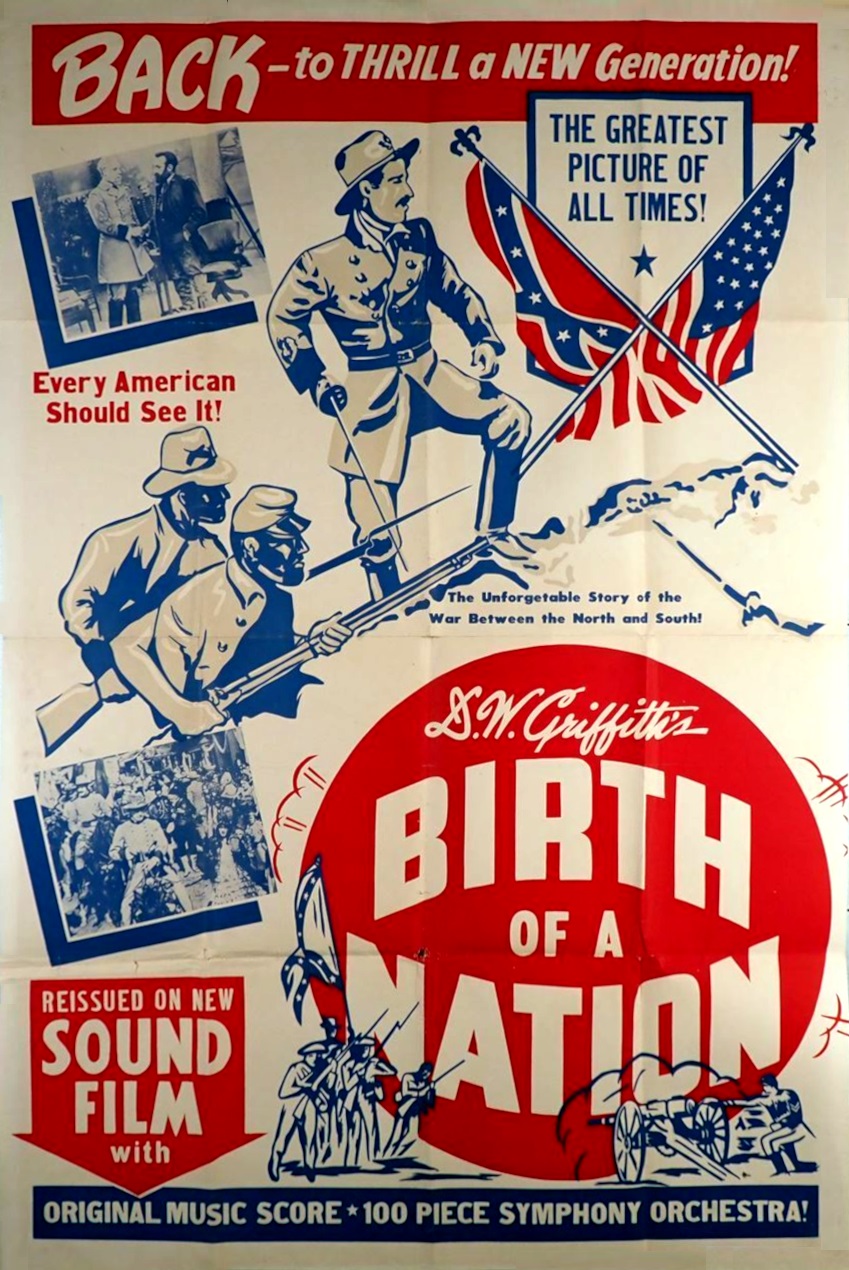 Reissue poster, Tuesday, 2 December 1930. Distributed by the Epoch Producing Corporation. |
|
Now, unexpectedly, it’s back again:
|
|
Chelsea Rialto Studios, BIRTH OF A NATION Talkie Reissue Blu-Ray Trailer, posted August 15, 2022 If Vimeo ever disappears this video, download it. |
|
As the years ground on, some minor distributors reissued some silents with soundtracks
and made a
|
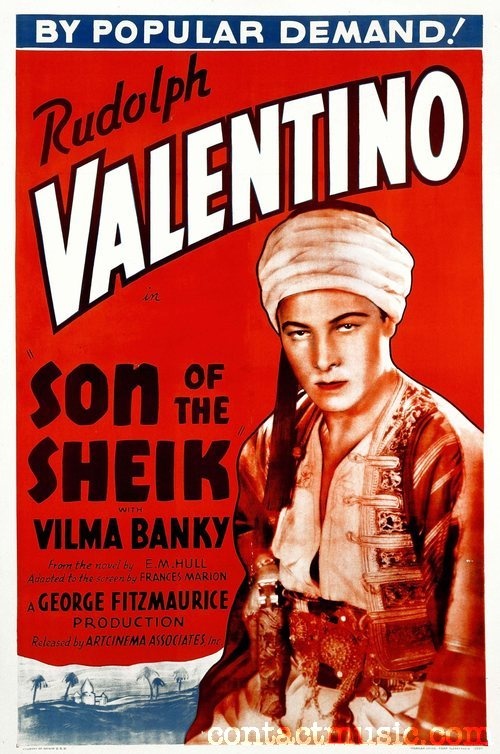 Reissue poster, 10 April 1938. Artcinema Associates, Inc. |
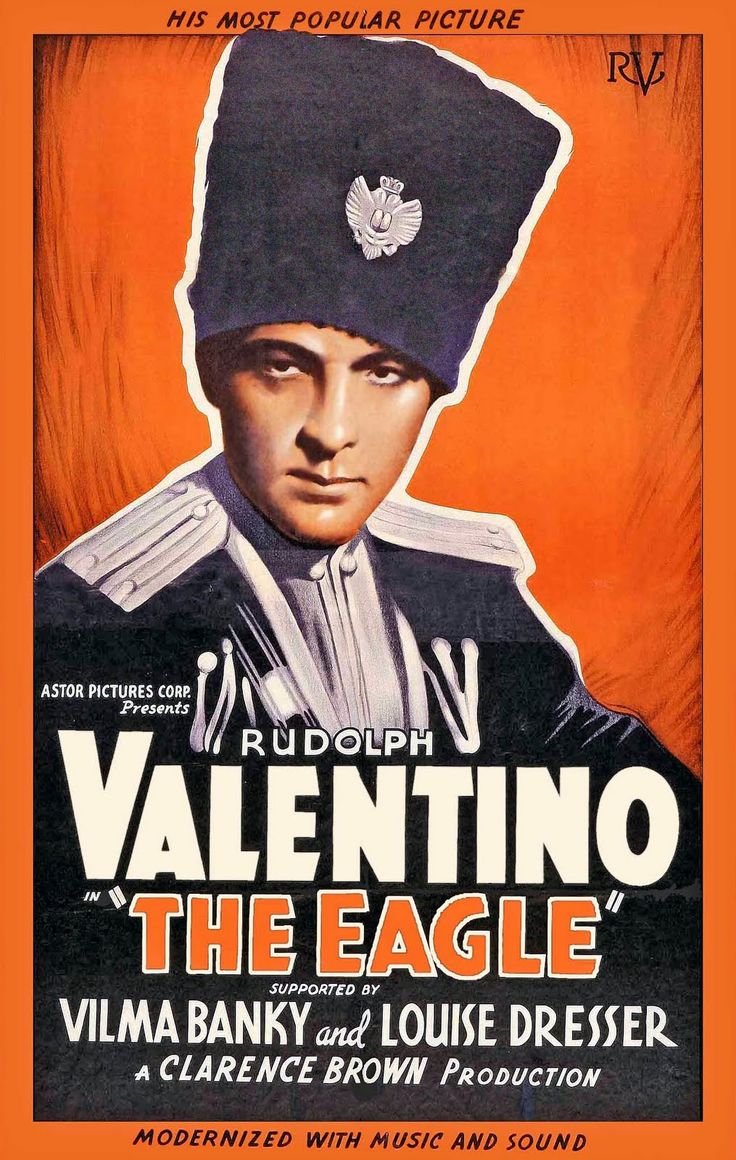
Reissue poster, 14 January 1939. Sound version produced by Astor Pictures Corporation... |
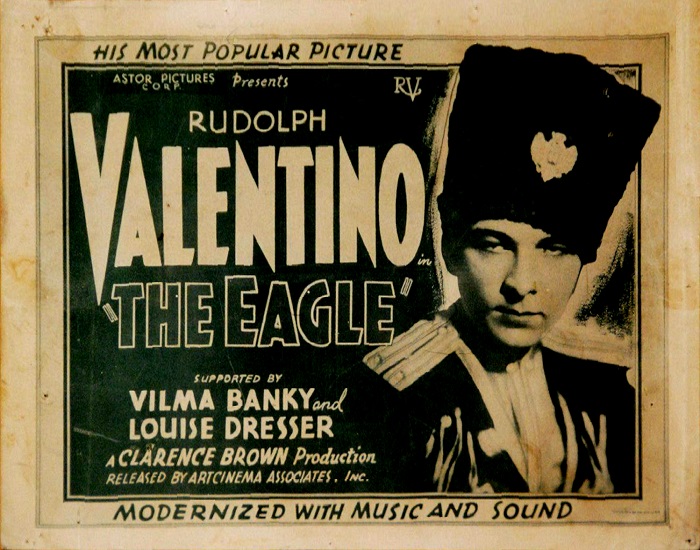 ...but distributed by Artcinema Associates, Inc. | |
|
William S. Hart offered a
spoken prologue to
Tumbleweeds in 1939 synchronized by James Charles Bradford,
produced by Astor Pictures Corporation.
|
|
Not long afterwards came Goldwyn’s October
1940 reissue of
The Cabinet of Dr. Caligari.
As far as I know, the music score consisted of a bunch of royalty-free library recordings all spliced together.
|
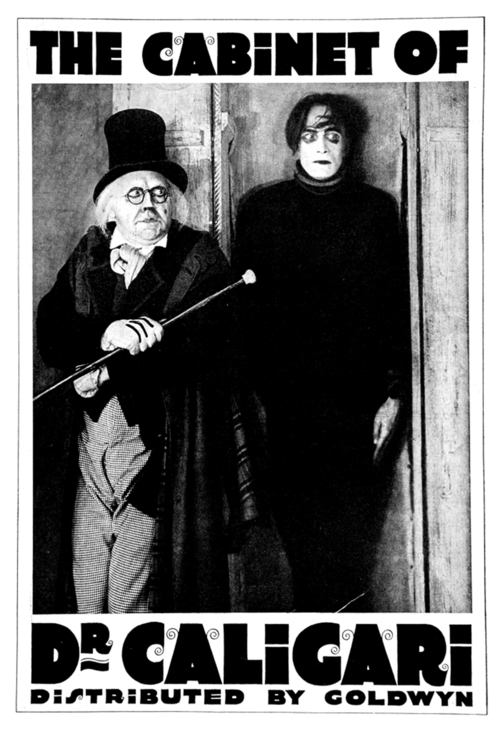 I’m pretty sure this is the 11 October 1940 reissue poster. Well, no, darn it, it isn’t. This is part of the 1921 campaign. No idea what the 1940 poster looked like. Oh. I lied. I found a lobby title: |
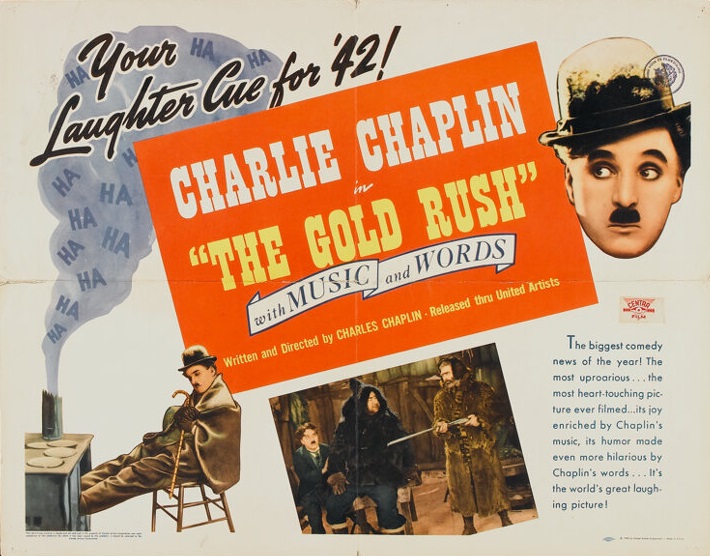 4 March 1942 reissue, “with MUSIC and WORDS” (and the left side lopped off) |
|
When Charlie Chaplin decided to reissue The Gold Rush in 1942,
he took some lessons from the above reissues, but did not follow their path.
He composed a score himself and commissioned an orchestra to perform it.
He added narration and dialogue, but spoke it all himself.
He
|
|
There was also the Associated British Picture Corporation, which was a major distributor.
In 1948 it reissued an unusual edition of
Metropolis,
which, amazingly, retained the entire image through optical reduction!!!!!
That was a true a rarity, perhaps unique for the time.
The music score, predictably, was spliced together,
this time from the Queen’s Hall Light Orchestra’s
|
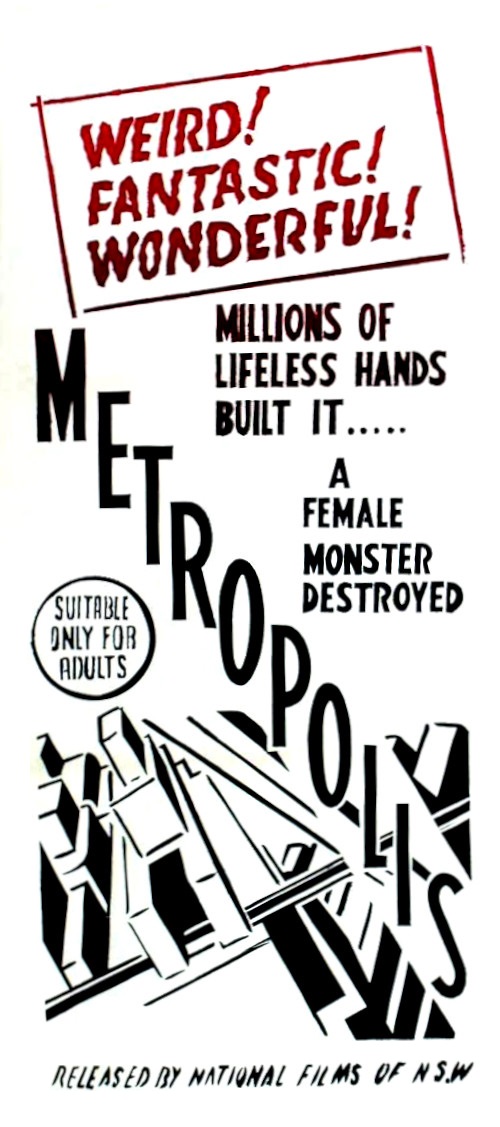 Australian reissue daybill, Thursday, 20 June 1952. Distributed by National Films of N.S.W. I have never found the poster for the British reissue of 1948. If you can find it, please let me know. Thanks! |
|
This was not 1950. The British reissue was Monday, 5 July 1948, and the Australian reissue was Thursday, 20 June 1952.
I’m pretty sure this was the edition that Janus Films later distributed
to cinemas (but NOT to television or video!) from 1972 through 1982,
and which has never been seen since, which is a terrible pity.
It was not like any other available copy of the movie.
|
|
In 1950, Howard Underwood reissued the 1928 general-release edition of Uncle Tom’s Cabin,
now with a new narration track, but he did this without any authorization.
If anybody has a copy of this 1950 edition, I would love to see it, hint hint.
|
|
In 1953, Universal successfully sued Howard Underwood
and planned its own reissue, but instead sold all rights to Colorama Features,
which reissued the film in 1958
with a new prologue and relentless narration featuring Raymond Massey.
The film was slashed mercilessly to utter incoherence, and I had to stop watching after just a few minutes.
It was a disgrace.
|
|
Film Renters, Inc./Famous Films Productions, Inc., reissued
Caligari and
The Last Laugh as a
double bill in September
1952.
I suppose that the Caligari music was simply copied from the 1940 release.
The music cues for The Last Laugh were likely also spliced together from royalty-free library recordings.
|
|
Why do these claim a copyright by “The Attorney General of the United States of America”?
My guess is that the United States Office of Alien Property snagged these movies during the war
and then cleared the way for public showings upon the signing of treaties.
Note that the presenter was Film Renters, Inc., and that the distributor was something called Famous Films Productions, Inc.
What, pray tell, were they?
They both shared the same address, and so Famous was certainly the distribution arm of Film Renters, Inc..
|
|
Sol Lesser’s Odyssey Pictures, Inc., produced a sound edition
of Douglas Fairbanks Senior’s The Iron Mask, now with Doug Junior narrating.
[Robert] Lippert Pictures, Inc., distributed in 1953, probably beginning 1 November (after a few tests),
though the exact dates are difficult to pin down with certainty.
It played apparently to no acclaim whatsoever.
Greenbriar posted a page about this.
|
|
Such modernized silents were offered on an individual-booking basis to a handful of neighborhood cinemas and then they vanished.
We need also to remember the handful of cinemas in larger cities
that would occasionally rent an antique print of a silent film and run it for a few days.
That could only happen if an ancient print happened still to be collecting dust at the local exchange.
Such revivals were relatively rare.
|
|
Other than the infrequent reissues and the rare revivals,
silent films were treated largely as a joke, good for a few scornful laughs.
That tradition began around 1930 and continued unabated for decades.
The distributors abridged and excerpted silent films atrociously,
took less than zero care to get acceptable image quality,
added preposterous narration together with exaggerated sound effects, and a good time was had by all.
Here is an example of this tradition,
with narration by 26-year-old Peter Sellers, just as he first became a household name.
The result is about as amusing as a case of the measles
but it is nonetheless an interesting curiosity to puzzle over:
|
|
Videoteca do Jota, Charlie Chaplin - A Burlesque On Carmen (1952 Version with Peter Sellers Narration), posted on Jun 26, 2018 When YouTube disappears this video, download it. |
|
Of course, film clubs — and in the 1970’s Shakey’s Pizza Parlor —
were somewhat more respectful, but their offerings were limited and their audiences even more so.
The point at issue was how silent films were being presented at cinemas and on television,
and the results were far from good.
|
|
Buster would have none of that.
He wanted his films presented with dignity, with appropriate music, no narration, no sound effects.
Unfortunately, KirchMedia compromised his ideas,
but nonetheless the reissue of Der General was a first:
a full-length feature, essentially in its original edit, with a specially commissioned music score, without sarcastic commentary,
and with a major international roadshow release.
I imagine there were countless doubters who were convinced that this experiment would go over like a lead balloon,
but, instead, it was a gigantic hit.
|
|
Goldrausch. Seemingly to capitalize upon the success of Der General,
Atlas shortly thereafter issued
a Charlie Chaplin movie called The Gold Rush
from material that Raymond Rohauer had illegally supplied to Beta Film GmbH.
To explain this story, sorry, will require a bit of a dive into the world of Chaplin v. Rohauer.
There’s really no way to explain this without going on this unexpected extra journey.
If you’re a movie buff, you’ve heard and read this story already,
but you probably never encountered sufficient details to make sense of what happened.
So read it again. Ready?
|
|
History lesson:
The modern claim is that Charlie continued to shorten The Gold Rush during its Hollywood and NYC openings
and only afterwards settled upon a definitive final
|
|
Charlie
sneaked The Gold Rush at the
Forum after the last show on Thursday, 28 May 1925,
entirely unannounced.
It was
TEN REELS long.
Surely the accompaniment was an improvisation on the Kimball 4/37.
I wonder who the organist was, and I wonder if s/he was given any prep for the performance, or just played it cold.
Sid Grauman, who had contracted with Charlie to be the first to exhibit the film exclusively at the Egyptian,
exploded in rage, and Charlie had to go to great lengths
to appease him and rescue the contract he had breached.
|
|
The preview print that opened at
Grauman’s Egyptian in Hollywood on
Friday, 26 June 1925, was 9,760'
(120 min. at the speed used that evening, but it would have been about 109 min. at 24fps).
Rachel Ford (pronounced RahSHELL) later reported that it was about 10,500' (about 117 min. at 24fps),
and she later corrected that figure to 10,250'.
Impossible.
(I bet she learned the running time and calculated it at 90'/min.)
Carli Densmore Elinor hammered together the score from
standard cues, and Belwin, Inc., of NYC published it.
|
|
Cues:
“On the Bowery” (1891) “My Wild Irish Rose” (1899) “Auld Lang Syne” (1799) “Loch Lomond” (traditional, first published in 1841) “Waltz Me around Again, Willie” (1906?) “Pretty Maiden Milking a Cow” (traditional, 18th century) “Fascination Waltz” (1904) “A Thousand Kisses Waltz” (1910) “The Wandering Minstrel” (traditional) “When I Look into the Heart of a Rose” (1918) Charlie was adamant about not wanting to use contemporary jazz music. |
|
Gino Severi conducted the orchestra.
Julius K. Johnston played the organ solos, which I presume were between the screenings.
At the gala opening, the film was TEN REELS, which is consistent with 9,760' and is certainly less than 10,250'.
Variety reviewer Wally
(a misprint for “Waly.” whose full name is unknown to me)
noted that the ten reels lasted precisely
120 minutes,
consistent with Charlie’s favored projection speed of 81⅓'/min., or a little under 22fps.
There is a story that Charlie chopped a reel’s worth of material out of it after the première
(Matthew Solomon, The Gold Rush: BFI Film Classics, 2015, p. 12; referencing Wife of the Life of the Party, p. 64).
This story comes from Lita Grey and is probably correct.
I believed it. Then I didn’t believe it.
Now I’m beginning to believe it again.
Yes, Charlie could easily have trimmed the film.
After all, the copy shown at the Egyptian was not a finished print,
but was physically spliced together and likely was straight black and white.
The negative would not be cut until a little after this preview opened,
and that was because Charlie thought he might need to make changes before making the film final.
Surprisingly, the booking at the Egyptian was not merely a preview;
it became a true roadshow presentation, as it was popular enough to run for
18 weeks and 3 days!
Back in those days, it was a rarity for a
|
|
The film was in its final form for its Manhattan première on Sunday, 16 August 1925, at the
|
|
The print that Charlie’s people submitted to the copyright office was TEN REELS,
which would accord with 9,760' or thereabouts.
The Copyright Office granted it registration number
L 21805 on Tuesday, 13 October 1925.
There is a claim that the Copyright Office received a print of
8,555' (about 95 min. at 24fps),
a claim I found preposterous, but which I am now beginning to suspect was correct, or close to correct.
That would mean that the film was assembled onto ten short reels.
The film was definitely on
TEN REELS, despite everything you have ever heard and read to the contrary.
The
pressbook specified that it was TEN REELS.
Countless reviewers of the time, all across the country, commented upon the length, and they all mentioned TEN REELS,
which was unusually long for a comedy.
Of course, Charlie wanted it projected a bit slower, somewhere around 22fps,
and that would have lengthened the above running times somewhat.
9,760' is 118 minutes at 22fps but 109 minutes at 24fps.
If projected at 80'/min., which had been a recommended speed beginning in about 1914
through about 1922, it would have run 122 minutes.
(80'/min. = 21⅓fps.)
So it seems that Charlie wanted it just a hair above 81'/min.
Once sound came in, though, Charlie was perfectly okay with the movie being shown at 24fps.
|
|
Come 1931 the film was played out and nobody was booking it anymore.
Charlie withdrew it from release in May 1933.
|
|
Now for supplementary evidence.
The
pressbook on page 20, in an article entitled “Chaplin’s Comedy Built on Tragedy,”
mentions “the nearly nine thousand feet of film.”
On the same page is another article,
“Funniest Chaplin in ‘Gold Rush,’” which concludes:
“there is a laugh in every one of the eight thousand or so feet of ‘The Gold Rush.’”
Go down to page 23 and read an article entitled “Chaplin Makes Laughs of Heartaches and Tragedies,”
which reiterates that “There is a laugh in every one of the
nearly nine thousand feet of film in ‘The
Gold Rush,’ says one of Chaplin’s close
associates.”
This is probably where Rachel Ford got her idea that the film was roughly 8,900' when it reached NYC.
|
|
Now, here are a few items we saw before, but we need to consider them again,
this time in a new light.
|
|
As you will recall, Arctic Adventures was a pirated copy (abridgment?) of The Gold Rush.
As such, it would have derived from a genuine copy.
Alas, when Charlie brought suit against the suppliers, all copies vanished.
If any copies still survive, it is of utmost importance that they be scanned and preserved.
Even though this edition is probably an abridgment, it would tell us a great deal about which takes and camera angles
were in the original domestic edition of the film,
and it would also offer good evidence about the editing and pacing,
and quite possibly would include the original titles.
|
|
At the pleading of Iris Barry, Charlie agreed to deposit a copy of all the films he controlled
at the Museum of Modern Art (MoMA), and yet, so far as I can tell, MoMA never made 16mm copies for educational institutions.
That was in the second half of 1935.
Then in 1939, Charlie gave Billy Gilbert a 16mm copy of The Gold Rush as a gift.
Charlie afterwards set about revising the film for a reissue.
He viewed it again for the first time in years and saw problems.
“I thought I did a pretty good job of editing at the time.
But when I got it out for reissue I took a thousand feet out of it.
There was a subplot — something about The Girl sending
a letter to another fellow — which
got in the way of the story”
(John Chapman, “Hollywood,” The New York Daily News vol. 23 no. 225, Final Edition,
Saturday, 14 March 1942, p. 18).
In my opinion, and in the opinion of pretty much everybody else on the planet,
Charlie made a huge blunder by deleting that subplot.
The story needed that complication.
Simplifying the story ruined it.
|
|
Charlie’s 1942 revision, with dialogue and music, minus titles, with plentiful deletions and a few substitutions,
was a mere 6,474' or thereabouts (about 72 min. at 24fps),
and, predictably, the left side was lopped off.
Charlie sneaked it on Monday, 2 March 1942, at the
Fox Village in Los Ángeles
and premièred it at the
Orpheum
in Montréal on Wednesday, 4 March 1942, where it ran 6 weeks and 1 day.
What happened right after that, I do not know, but I do know that it opened on
Sunday, 3 April 1942, at the
Plaza in Vancouver, BC,
and ran for 4 weeks.
On Saturday, 18 April 1942, it opened at the
Globe
in Manhattan, where it ran for 6 weeks and 2 days.
On Tuesday, 19 May 1942, it had a double première at the
Paramount Downtown (formerly Grauman’s Metropolitan) and at the
Paramount Hollywood (formerly and subsequently El Capitán).
It ran 6 weeks and 3 days.
By about 1947 it had played out and nobody was booking it anymore.
In 1956, Charlie put it on the market again,
but, as far as I can tell, no distributor in the US would touch it since it was political suicide.
That’s when we need to segue into The Rohauer Story.
|
|
...In 1953, the Chaplin Studios were sold and
a great many barrels of Chaplin films were sent to the
American Film Recovery Company for silver recuperation
purposes. When the representatives of the Chaplin
Studios went to witness the destruction of the material,
they found the American Recovery Co.’s premises locked
and sealed owing to them having gone bankrupt.
Subsequently, the Fire Department demanded that the
material be destroyed, as it was mostly nitrate film.
The trustee in bankruptcy then sold all the material
for recuperation purposes, but... the buyer found
that he had acquired Chaplin pictures...
It is presumed that the pictures were
reconstructed fairly accurately, thanks to the multiple
copies of each film, an immense amount of
Incidentally, Rohauer has openly boasted
that he had prints or negatives of all the Chaplin films.
In order to give some substance to the
story of true ownership of the material, somewhere along
the line somebody had the idea of stating that Mrs.
Chaplin had signed a Bill of Sale.
My reason for telling you all this is that I
have recently heard a rumour as to the source of the
Beta Films’s GOLD RUSH. It mentions “bought at an auction”
and a “Bill of Sale signed by Mrs. Chaplin”.....
I would add that Mr. Rohauer has recently
stated that he is leaving the States to take up domicile
in Germany.
|
|
Rachel Ford’s surmisals were 100% accurate.
That is exactly what happened, in a nutshell.
|
|
If you can find a copy of Kevin Brownlow’s The Search for Charlie Chaplin,
grab it and read it.
There are far more details in it than I can summarize or even memorize.
Here is a passage, which quotes Rohauer:
|
|
There were no known prints of the 1925 version. Only the 1942 reissue.
I just decided to go through all the reels and make it up from the outtakes.
I had a few reels of cutting copy, and I worked with a professional
editor, Irvine Dumbrille, nephew of the actor
Douglass Dumbrille. I
found the original titles. Where there was no cutting copy, we just had to
take from these huge rolls scenes that we thought would match. If you really
look at it, it doesn’t match. It probably doesn’t match the original film
at all. But no one ever knew (p. 130 [English]; p. 140 [Italian]).
|
|
NOTE ON THE ABOVE: I can find no reference to any Irvine Dumbrille.
Yet there was a film editor named
Erwin Leon Dumbrille
Oh. It was Erwin. Take a look at
Dorkay Productions, Inc. and
Erwin Dumbrille.
So, yes, Rohauer was telling the truth that he was “a professional editor,”
but he did not bother to divulge that Dumbrille did not become “a professional editor” until nine years later.
Dorkay was actually spelled
|
|
So, let’s restate this.
Ray Rohauer and Erwin Leon Dumbrille (1930–2013),
created a new version of The Gold Rush partly from outtakes.
Portions of the cutting copy remained in those barrels of film,
and Ray and Erwin used those to guide them in piecing together something similar from outtakes.
Apparently much of the raw camera negative survived, or lavenders or copy negatives thereof.
When Ray and Erwin had access to a cutting copy as well as to the corresponding negatives or close derivatives,
they could exactly duplicate the 1925 film.
As you will see from the visuals below, there is a shot of Charlie eating his shoe
that is identical in the Rohauer edition and in the 1925 original.
David Shepard had in his collection the final tenth reel of a 1925 print of The Gold Rush,
and he maintained that it exactly matched Rohauer’s reconstruction.
See “Greenbriar
Picture Show blog on THE GOLD RUSH screenings” NitrateVille, 25 December 2007.
As for the rest of the film, for which no cutting copy survived, or for which masters had vanished,
Ray and Erwin guessed as they built the movie from outtakes.
Their result did not entirely match the 1925 original.
In addition to being built partly from rejected takes, it was also some 2,000' shorter than the original.
|
|
|
In
|
|
See the parenthetical note: “(Not available for exhibition or distribution in Va., Md., Penna. or N. Y.)”
Well, if it’s not available in Pennsylvania, then how do we explain the advertisement below?
|
|
|
|
|
Incidentally, the above three cinemas, the Stanton in Washington DC, the Ambassador in Philadelphia, and the Cameo in Baltimore,
were all run by
Robert B. Fischer of Artistic Films, Inc.
Apparently, this was the distributor, and it
claimed to have distribution rights also to
City Lights,
Modern Times,
The Great Dictator, and
Monsieur Verdoux.
Charlie had none of those films in release in the US at the time.
How do they get away with these things?
I’d love to learn more about this story, yes indeed.
|
|
It was probably only to drive Fischer’s print off the market that United Artists’ new subsidiary, Lopert,
reissued the 1942 edition in
1959.
That is precisely why UA purchased Lopert: to take the heat for more risqué and controversial and unconventional releases.
What to do about Rohauer, though?
|
|
Technically, it was only the 1942 edition of The Gold Rush that was copyrighted in the US.
Any other edition was up for grabs,
though the Chaplin team was finding powerful means of getting around the public-domain status,
specifically by reference to an underlying copyright that had most definitely not expired.
In Europe, though, the film in its entirety, in any edition, was still protected per the Berne Convention,
unquestionably, unambiguously, demonstrably, definitively.
So Rohauer decided to get even braver, if brave is the word.
Maybe a better word is impudent.
He took the battle to Europe.
|
|
Rohauer, through Paul Schmitt’s shell corporation, FilmArchiv Internationale of Vaduz,
licensed the film to Beta Film GmbH of Munich.
Beta, operated by Hans Andresen, sublicensed the film to Atlas Filmverleih GmbH of Düsseldorf, also operated by Hans Andresen.
Never mind that United Artists had warned Hans Andresen to keep his hands off of that material.
Beta/Atlas probably did not know that
Rohauer was the defendant in a protracted lawsuit that Chaplin had filed over this film.
After all, why would Rohauer be bothered to divulge such a picayune detail to a distributor?
Atlas added
a new music score compiled from previously recorded pieces by Konrad Elfers.
One of Chaplin’s complaints was that the titles were not translated from the originals,
but were instead translated from (Rohauer’s) rewrites.
I am not convinced. I need more evidence before I judge one way or the other.
This new edition opened no later than 2 April 1962, probably a month or so prior to that.
|
|
|
I would pay good money to get a copy of the Atlas/Elfers edition. Hint hint.
It was apparently available in 16mm and at least one copy was offered on eBay some many moons ago,
and a five-minute reel of excerpts was once offered on Super 8 mag sound through
Video-Archiv – Film Produktion,
FL 9490 Vaduz, Postfach, accidentally on purpose without the Postfach number,
and certainly with no street address, because
there wasn’t one.
In later years, the incomplete address was supplied as
FL. 9496 Balzers.
|
|
I have been scouring Google and have so far discovered
several Super 8 items from Video-Archiv,
of all manner of films from clips to full features,
from children’s cartoons all the way to unmentionables,
and in none of these images is the Postfach number supplied.
All these films state something to the effect of
“Allein vertrieb durch (Solely distributed by) INTERNFILM,
623 Frankfurt am Main 80,
Bolongarostraße 141, Telefon (06 11) 30 40 43.”
INTERNFILM also had a PO Box address:
Postfach 800 732,
as well as a different telephone number, (06 11) 31 64 38.
Some of these reels, instead of listing the sole distributor as
|
|
Charlie sued Atlas for violation of copyright.
The record is not clear, but it appears to me that Atlas sought an agreement
and was willing to ditch Rohauer’s version and instead to release Charlie’s preferred edition,
but whether prior contracts or smouldering resentment prevented that, I do not know.
Atlas’s lawyers then went on the warpath,
searching for every meaningless loophole they could think of.
|
|
When Rohauer had a quarrel with Atlas/Beta, he offered to switch sides
and to assign his edition’s rights to Chaplin’s company.
It appears to me that the Chaplin side did not respond to this offer,
as Chaplin wanted to have no dealings with someone he regarded as a pirate.
|
|
In the meantime, in June 1963 the court agreed with Chaplin
to have Atlas to destroy all its materials on The Gold Rush,
positive and negative, including all publicity material.
The court confiscated at least two battered 35mm prints,
both of them composites, and those two prints ultimately ended up
at the Deutches Institut für Filmkunde in Wiesbaden.
Nonetheless, Atlas appealed the decision and continued to show the film.
The case dragged on for years —
and Charlie was largely to blame for dropping the ball.
He was afraid to allow his lawyer to enforce an injunction,
fearing that some technicality might cause the case to backfire,
and then he refused to hear any more about the case for a full year
as he was busy working on A Countess from Hong Kong.
That is why he declined to appear in court for scheduled testimony.
Nonetheless, Chaplin at long last won his case on 19 May 1972.
So any stray prints, if there are any, would be invaluable documents,
as they would contain a music score not heard since 1972.
If this edition of the film still exists, I hope that the Chaplin executors
will see their way to clear it for release, if nothing else as a
|
|
There is a claim that the 1962 Atlas/Elfers edition was
2,720m long, or about 8,924', which, at 24fps, would run 99 minutes!!!!!
That’s according to one source, in a footnote.
I entirely disbelieve that claim.
According to Charlie’s German lawyer, though, Atlas’s edition was
2,134m, or 7,001' (about 78 min. at 24fps).
Whenever you hear someone say, “The truth is somewhere in between,”
the one thing you know for certain is that the truth is not somewhere in between.
In this rare exception, though, I suspect the truth really is somewhere in between 8,924' and 7,001'.
Both those figures seem awfully wrong to me, one far too long and the other far too short.
|
|
According to
kinoart.net, Atlas reissued its 1962 edition in 1968.
Since the appeals were continuing, well, why not?
According to
Synchron-Forum,
the 1962 Atlas/Elfers edition was even broadcast on ZDF in 1969!!!!!
|
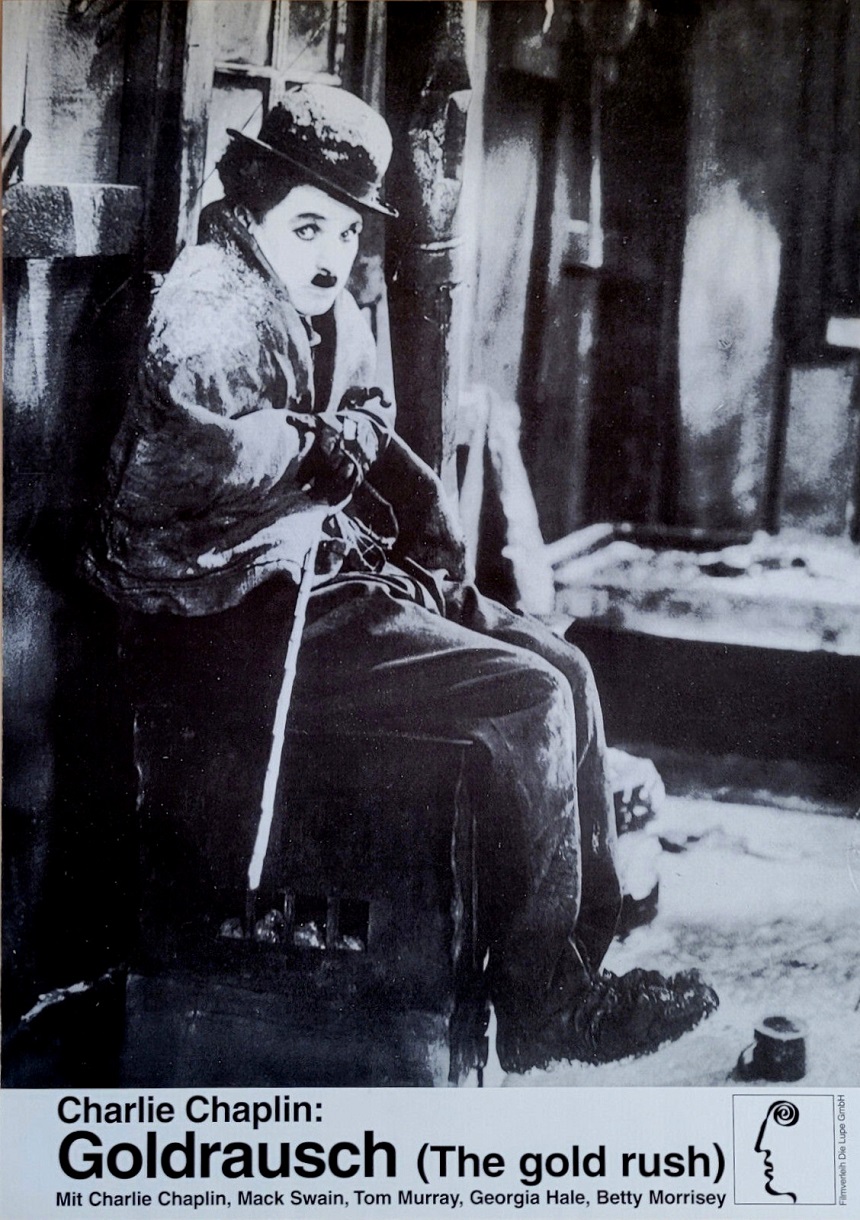 I wonder if this poster from Filmverleih Die Lupe GmbH, which uses the same logo as Neue Filmkunst Walter Kirchner, was used for the 1968 reissue. |
|
For some reference points, you will want to read through the endless legal correspondence
posted by the Chaplin Archive:
Violation of Copyright: Atlas.
I’ve just skimmed it so far.
It would take days and days and days for me to plough through it all.
Can I find the time? Yes, I can. Eventually.
|
|
Chaplin prevailed in his suit against Rohauer in 1966,
and Rohauer was compelled to surrender all his materials.
Curiously, it was also in 1966 that film clubs throughout the US began showing The Gold Rush.
My best guess is that the film clubs were purchasing or renting John Griggs’s Moviedrome edition.
|
|
These are the presentations I have so far been able to discover for the year 1966.
There were surely others:
|
|
• Tuesday, 1 February 1966:
Robert E. Lee of Nutley, NJ, president of the
Essex Film Club, presented a silent print of The Gold Rush at the Garden State Shopping Center in Paramus.
Accompanying on piano was
Paul
Norman
(12 Nov 1910 –
19 May 1969),
“a resident of Jersey City, one of the metropolitan area’s few remaining silent film piano accompanists.”
This must have been the Griggs-Moviedrome edition. Must have been!
• Friday, 15 April 1966: The Delaware County Evening Branch of the Women’s International League for Peace and Freedom presented The Gold Rush at the Community YMCA in Lansdowne, PA. The source of the print? A private collector, Professor Peter van de Kamp. How, when, from whence did Professor van de Kamp come to acquire that print? I bet he simply purchased the Griggs-Moviedrome edition. Who did the music? • Friday, 13 May 1966: The Gold Rush was presented at UC Irvine, with organ accompaniment by Chauncey Haines, “ last of the silent film-era organists.” • Friday and Saturday, 15 and 16 July 1966: Union Movies, on the campus of the University of Utah in Salt Lake, scheduled the “original, • Saturday, 17 September 1966: Tom Simone, founder of the Tempe Film Society, booked films solely through the Museum of Modern Art. Well, this night was probably the exception. Who did the music? • Tuesday, 27 September 1966: The Menomonie Theater Guild presented a series called “The Nickelodeon Days” at the gorgeous 1889 Mabel Tainter Memorial Theater. On this night, the offering was The Gold Rush, “the complete and original version.” Don Mortwedt, president of the Guild, wistfully exuded, “The house lights are down, the pianist is tinkling out the theme melody....” Who did the music? • Friday, 11 November 1966: The Memorial Junior High School in Fairlawn, NJ, presented The Gold Rush accompanied on the piano by (once again) Paul Norman. • Saturday, 19 November 1966: An unnamed piano player accompanied The Gold Rush at UNM in the SUB Ballroom. • 1966: Most confusing of all was a TV series called The Charlie Chaplin Comedy Theatre. This was a 24-episode show that premièred on 1 September 1965 in St. Petersburg, FL. It was available only to local stations and was never shown on network. It consisted of
Well, I went through all the listings, and I guarantee you that the series never included The Gold Rush.
I don’t see how it could have.
Would Professor van de Kamp have loaned his print? Maybe.
Would James Dukas have loaned his print? Maybe?
Would MoMA have loaned its print? Impossible.
As for the music, The Charlie Chaplin Comedy Theatre pulled its royalty-free music
from the Thomas J. Valentino Production Music Library.
This listing shows us that a broadcast of The Gold Rush was indeed planned for this series, but it never happened.
|
|
This is topic f/s 16mm feature THE GOLD RUSH Charlie Chaplin in forum
16mm films for sale/trade/wanted at 8mm Forum.
To visit this topic, use this URL: https://8mmforum.film-tech.com/cgi-bin/ubb/ultimatebb.cgi?ubb=get_topic;f=6;t=001169
Posted by Stefano Cacciagrano (Member # 2751) on July 05, 2013, 08:18 AM:
I’m selling Chaplin’s THE GOLD RUSH (1925) Amazing print for British tv, from series “The Movies — Our Modern Art”, with original main titles and intro about Movies and Chaplin 1 Hour version, with narrator voice of Michael Whorf (english language) Print in good shape, optical sound, on cores Price 149 euro plus ship Here's pics from projection: http://annunci.ebay.it/annunci/film-e-dvd/rieti-annunci-rieti/film-16mm-la-febbre-dell-oro-the-gold-rush-charlie-chaplin/50055288
Visit www.film-tech.com for free equipment manual downloads. Copyright 2003-2019 Film-Tech Cinema Systems LLC
 UBB.classic™ 6.3.1.2 |
|
Hey, when it pours it rains.
Here’s the other one:
|
|
Produced By
Atkinson, Dennis, American Subject Of Chaplin, Charlie, English, 1889 - 1977 Owned By Smith, Ernie, American, ca. 1925 - 2004 Date 1969 Medium acetate film Dimensions Duration (digital file): 00:30:51 Physical extent (film): 1150 ft Description A motion picture film with scenes from the first half of The Gold Rush, the 1925 feature film. It consists of a single reel of positive, black-and-white, acetate film with bilateral variable-area optical sound. The film starts with [“THE GOLD RUSH” / PART / 1] appearing briefly in the leader. After a few cameo shots, [THE MOVIES / OUT MODERN ART] appears on the screen while footage of a film set can be seen in the background. A narrator then begins discussing topics such as Hollywood and filmmaker Charlie Chaplin while scenes from The Gold Rush play in the background. At one point, the narrator says, “In 1925, he made what is considered today by many film historians to be the funniest comedy ever made: The Gold Rush,” after which two title cards appear on screen. The first reads [Walter Reade/Sterling, Inc. / presentation], while the second reads [Charles Chaplin / in THE / GOLD RUSH / copyright © MCMXLXIX by Spectra Pictures / All Rights Reserved]. The opening credits role after both title cards and include cast and crew for the original 1925 film and the “New Version.” Individuals credited in the re-release include James L. Limbacher (narration author), Michael Whorf (narrator), John Muri (composer and performer), Joseph Siracuse (sound engineer), William Gyrofy (associate producer), and Dennis R. Atkinson (producer and supervisor). The rest of the film features scenes from The Gold Rush, with occasional narratorly comments. Place Filmed California, United States, North and Central America Classification Media Arts-Film and Video Type sound films black-and-white films (visual works) 16mm (photographic film size) film clips Topic Comedy Film Jazz (Music) Credit Line Collection of the Smithsonian National Museum of African American History and Culture, Anonymous Gift in memory of Ernest (Ernie) R. Smith, Jazz Historian Object Number 2015.275.43.1a Restrictions & Rights Restrictions likely apply. Proper usage is the responsibility of the user. GUID http://n2t.net/ark:/65665/fd56726723c-4bfb-4142-9721-498d10f37566 |
|
Ah! Note the credits! Walter Reade and Sterling, Inc., worked closely with Paul Killiam.
Could this abridgment have been a prélude to Killiam’s broadcast on WTOP/9 in Washington, DC, the following year?
Abridging it to 60 minutes would be rather in keeping
with Killiam’s normal practice of shortening films to fit TV time slots.
The copyright was by Spectra Pictures Corp., which had rights to some educational films at about that time.
I know nothing else about the firm, though.
Fascinating that Joe Siracusa gets a misspelled credit.
I wonder how he got involved in this, and I wonder precisely what he contributed.
This was about the time he got the assignment to compile and perform a score for The General,
and so maybe he applied for this gig to get a chance to work with and learn from a legend?
|
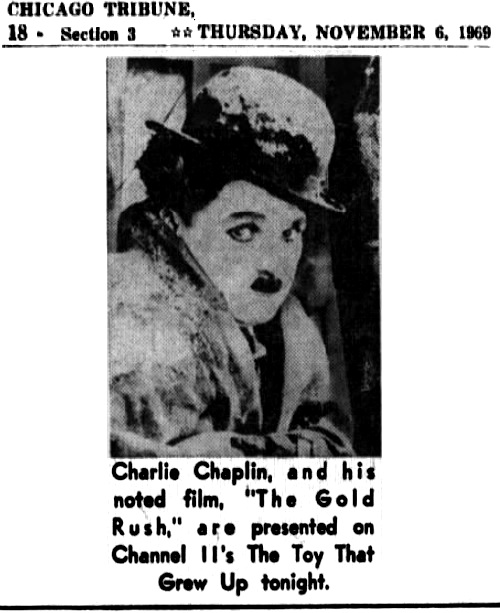
|
|
The Gold Rush was never included in “The Charlie Chaplin Comedy Theatre,”
but it was included in a different series, on WTTW/11 Chicago, a program called
“The Toy That Grew Up,”
distributed to other educational TV stations through ETS Program Service
(Educational Television Stations Program Service of Bloomington).
I do not know the full schedule, but in Chicago that episode aired on
Thursday, 6 November 1969, with
Hal Pearl accompanying on a small electric organ.
It was almost certainly a Griggs-Moviedrome print.
|
|
Now we can circle around to Paul Killiam and his Killiam Shows, Inc.,
which brought The Gold Rush back, this time to commercial television.
This was announced as the “world television première” of The Gold Rush,
on Friday, 22 May 1970, on WTOP Channel 9 (a CBS affiliate) in Washington, DC.
Never mind that a year prior it had been broadcast on West German station ZDF
as well as on Chicago educational station WTTW/11.
|
|
For this TV version, the music score was performed on the Radio City Music Hall’s Wurlitzer organ.
No idea who played it.
Well, hmmmmm, might this have been John Muri’s score?
Was it John Muri who had scored Rohauer’s edition in 1954?
Did Rohauer really book Radio City Music Hall for a mere organ score?
Or did Killiam or WTOP/9 commission a new organ score, probably from John Muri?
Whatever this score was, I would just LOVE to hear it. Did anybody happen to record it?
Killiam had Karl Malkames add tints, without reference to the film’s original tints,
which at the time were unknown.
|
|
For decades now, I have had to restrain myself from throwing pots and pans at people who say
that Paul Killiam’s edition of The Gold Rush is the original silent edition from 1925.
IT IS NOT!!!!!
Bruce Lawton revealed the origin of Paul Killiam’s
unauthorized 16mm edition of 1970 and his unauthorized 35mm
|
|
As one of the late Paul Killiam’s right-hand men — I can shed some light on the
history of the “Killiam” GOLD RUSH.
Paul was gearing up for THE SILENT YEARS around 1969/1970 for Public
Television. Color was a relatively new addition to TV and WNET wanted to play
it up for all that it was worth. When they found out that some of the silent
films that Paul would be providing were tinted — they then wanted ALL of them
tinted — regardless of whether they should be or not.
Another consideration was having a Charlie Chaplin film to open the series. THE
GOLD RUSH (with its unchecked PD status at the time) was the obvious choice.
Paul actually commandeered a
About a year or so later — Paul got many inquiries to rent THE GOLD RUSH in
35mm for screenings. As he had only produced a 16mm negative — he would need a
35mm negative to make prints to satisfy these requests. He went to his inside
source again to once again obtain access to the Rohaeur 35mm print between
bookings. However, when the material arrived it was clear that a lot of the
print had been mangled and was beyond copying. Paul was undeterred though and
did three things 1) copy what he could of this material, 2) got his hands on a
print of the ’42 version and filled out what he needed and 3) resorted to going
back to a 16mm print of his tinted edition and blowing it up to 35mm to fill
out the rest. The resulting 35mm negative was done in black & white.
So the tinted 16mm and black & white 35mm Killiam editions of THE GOLD RUSH
actually have differences between themselves(!). The 35mm is actually a bastard
child (of probably several bastard children) and Perry’s score had to be
“fitted” to the new 35mm edition.
The tinted 16mm edition was released on VHS and laserdisc through Republic. The
black & white 35mm edition was released only on laserdisc through Voyager.
Hope this saga clears up some questions and misconceptions.
|
|
That should answer your long-standing question
from that day, many years ago, when you examined a Killiam 35mm print on an inspection bench.
Why was it so inconsistent?
Why were half the shots hard-matted at the Academy format and
why were the other half full height with the left side lopped off?
Why were yet other shots of utterly miserable quality?
Now you know.
As for the “
|
|
...It was when Kevin [Brownlow] learned from David
Shepard that Bill Pence, who runs the Telluride
Festival, had a 35mm print, that these pieces of
the
Bill was very helpful when I spoke to him.
Yes, he had a 35mm of the 1925 Gold Rush,
but it was cropped and had an organ sound track. It
was the Rohauer version that he had bought in
1967 from a man called Bob Fischer who operated
from Texas, and was some kind of an associate
of Rohauer’s. But it was very worn and
battered now; better to use Killiam’s, unsatisfactory
as it was, because it had been made
from his print in the early ’70s. Why was Killiam’s
35mm so much poorer than his 16mm?
Well, Killiam made his first copy around 1967 [sic, actually 1970],
and probably because that was all he could
afford, Killiam arranged with Bill to make a
16mm negative. Later, Killiam decided to make
a 35mm copy and borrowed Bill’s print again.
Bruce Lawton discovered a hidden file; in this
was correspondence revealing that because Pence’s
print had suffered so much in the intervening
time from having been projected so often,
Killiam was forced to use
|
|
“So that was one mystery solved”?
Yes, but it brings up another mystery, which we shall witness in a while.
Have patience.
We’ll get there.
|
|
MVerdoux, Chaplin experts: Alice Artzt & Bonnie McCourt - 1991, posted on Mar 25, 2013. When YouTube disappears this, download it. |
|
After decades of court battles, the Chaplin estate was eventually able to quash the Killiam edition.
Thank heaven I have it on laserdisc, both the Republic and Voyager issues.
Bill Perry later
rearranged his piano score for a small ensemble for the film,
and I would LOVE to get a copy of the film with that ensemble score.
|
|
Please watch the video below.
William Perry hired someone to upload this to YouTube,
but whoever he hired lopped off the top and bottom of the image
to
|
|
William Perry, The Gold Rush with Charlie Chaplin, Score by William Perry, posted on Jul 14, 2014 Medley of excerpts from Bill Perry’s exceptionally fine ensemble accompaniment. |
|
Look what I just found:
“George Eastman Museum Receives Reels of Rare Nitrate Films.
ROCHESTER: Gift Includes Rare Vintage-Tinted Reel of Charlie Chaplin’s ‘The Gold Rush,’ Made in 1925,”
Niagara Gazette, Thursday, 25 February 2021.
By dumb luck, someone at Eastman put a little bit of film on a light table to take a snapshot,
and he/she chose the best of all possible frames:
|
|
Remember above when David Gill said,
“So that was one mystery solved”?
Now, let me show you something.
If a soundtrack were to be added to this full silent image, the left side would be lopped off.
Indeed, above we read sufficient testimony
to convince us that Rohauer did indeed lop off the left side to make room for the organ track.
The left side lopped off would look like this:
|
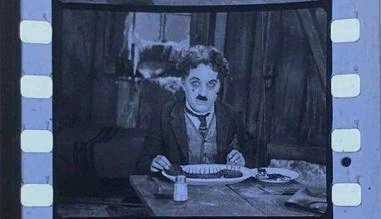
|
|
Yes, that is how much would be missing on a sound print,
unless, of course, the producer or distributor paid extra to have the frame optically reduced to fit the smaller width.
From all we have discovered above and shall discover below,
Rohauer most definitely did not pay the extra cost to have the image optically reduced.
He just lopped off the left side.
From all we have learned above,
Killiam copied Rohauer’s edition, which already had the left side missing.
So how do we explain why the left side is still there in the little video above?
|
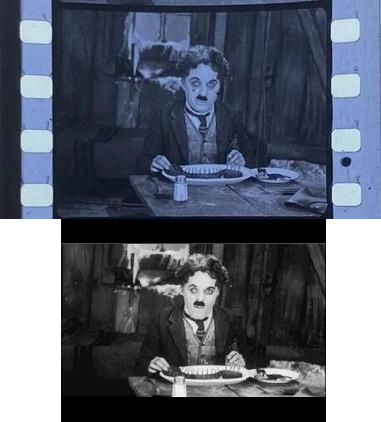
|
|
Yes, a smidgin of the width is missing from both left and right,
but that is the normal safety cushion, entirely to be expected.
It is not more extreme than that.
So there is still a mystery to be solved.
This particular shot likely did not come from Rohauer’s edition.
If it did, then Rohauer paid the lab to reduce the size of this particular shot.
But if he paid a lab to reduce one shot, then why didn’t he go whole hog
and pay the lab to reduce all the shots to fit the sound format?
|
|
Interestingly, when you click on
the link to Bruce Lawton’s comment,
keep scrolling down to the comment by
John Aldrich
who reminds us again of John Griggs:
“Griggs-Moviedrome used to sell a print of The Gold Rush that not only
was visually superior to the Killiam, but also had some footage that
was missing from the Killiam print.”
That would make sense, because Griggs-Moviedrome (with or without the hyphen)
copied some (all?) of its material from MoMA.
MoMA had authentic material on deposit, but never duplicated it to my knowledge.
Now I need to find a Griggs print somewhere, somehow.
Apparently the Griggs edition, though, was a mere nine reels, not ten.
My guess is that the reels were divided differently, since the 1925 general release was ten very short reels.
Really, though, I don’t know.
This is all guesswork.
Until I can study a Griggs print, I cannot know anything for certain.
|
|
There is more guesswork yet!
Take a look at “Chaplin Defends His Gold Claim” Greenbriar Picture Shows, Monday, 11 January 2010:
“Sellers used to compete by claiming their Gold Rush to be the most complete anywhere.
One I recall touted the inclusion of a rare assayer’s office scene where Charlie redeems his gold.
Collectors redeemed theirs for opportunity to possess a definitive Gold Rush...”
Was this the Griggs edition?
What was the source of this unidentified edition?
|
|
That is hardly the end of the story, though.
Too few people have commented upon
this story from February 2003:
|
|
Verzamelaars
Schatgraver met slapeloze nachten
Ergens in Voorburg staat een huis met verduisterde ramen waar celluloid de macht heeft overgenomen.
De woonkamer, de gang, de trap, de keuken en zelfs de wc zijn volgestouwd met filmblikken,
waarop oude stickers vergeten helden aanprijzen (‘Andy Clyde in Ze leren het nooit’).
Fenno Werkman (1956) is midden jaren zeventig begonnen met het verzamelen van masters van The Beatles
en daarmee verdiende hij genoeg om ook films te gaan verzamelen.
“Soms koop ik blind een hele container met films en dan maar hopen dat er wat tussen zit”, vertelt hij,
met tegenover hem de montagetafel waar Leni Riefenstahl nog haar films op heeft gemonteerd.
“Ik ben niet geïnteresseerd in blockbusters maar in maffe B- en
“Ik heb soms slapeloze nachten als er weer een fax uit Amerika komt met 5000 beschikbare titels.
Dan maak ik een lijst van films die me wel wat lijken.
Dat zijn er dan 2500, veel te veel natuurlijk.
Dus moet ik gaan strepen, en dat alles onder tijdsdruk.
Zo heb ik heel wat juweeltjes gevonden maar nog veel meer rotzooi gekocht.”
Avontuurlijk
Werkman heeft van veel films en concertopnames de enige kopie, zoals het eerste afscheidsconcert van Frank Sinatra in 1971,
Feast of friend over The Doors uit 1979 (nooit uitgebracht),
de enige
Ook filmhuizen kunnen films huren van Fenno Werkman, “graag zelfs”.
“Steeds minder programmeurs durven het aan om avontuurlijker te programmeren,
omdat ze bang zijn dat er te weinig publiek op af komt.
Ze moeten wel zelf de rechten regelen.
Pas 79 jaar na de uitbreng worden films rechtenvrij, daaarna kun je ermee doen wat je wilt.
Met oud en nieuw hef ik vaak het glas champagne met medeverzamelaars en dan proosten we altijd
op het feit dat er per 1 januari weer een paar duizend films rechtenvrij zijn.”
“Ik begrijp dat de rechten beschermd moeten worden,
maar de producenten en distributeurs kunnen best wat soepeler zijn tegenover filmvertoners
die eens wat anders willen draaien dan de commerciële films.
Verzamelaars worden verguisd door de grote distributeurs,
maar de liefhebbers zijn juist een van de weinigen die de films op waarde schatten en conserveren.”
Mariska Graveland
|
|
Are you astonished?
Probably not, unless you speak Dutch.
Shall we run that through an online translator?
|
|
Collectors
Treasure Hunter with Sleepless Nights
Somewhere in Voorburg is a house with darkened windows where celluloid has taken over.
The living room, hallway, stairs, kitchen and even the toilet are crammed with film cans,
on which old stickers tout forgotten heroes (“Andy Clyde in They Never Learn”).
Fenno Werkman (b. 1956) started collecting masters of The Beatles in the
“I sometimes have sleepless nights when another fax comes from America with 5,000 available titles.
Then I make a list of films that I like.
That comes to 2,500, far too many of course.
So I have to cross them off, all under time pressure.
That’s how I found a lot of gems but bought a lot more crap.”
Adventurous
Werkman has the only copy of many films and concert recordings,
such as Frank Sinatra’s first farewell concert in 1971,
Feast of Friends by The Doors from 1979 (never released),
the only
Movie houses can also rent films from Fenno Werkman, “gladly even.”
“Fewer and fewer programmers dare to program in a more adventurous way,
because they’re afraid it won’t attract enough of an audience.
They have to arrange the rights themselves.
Only 79 years after release, films become
“I understand that the rights need to be protected,
but it would be best for producers and distributors to be a little more lenient
towards film exhibitors who want to play something different from the commercial films.
Collectors are vilified by the big distributors, but enthusiasts are actually one of the few who value and preserve films.”
Mariska Graveland
|
|
Is somebody pulling our leg?
Is the movie 120 minutes only because Fenno slowed it down to 16fps?
After all, Killiam’s 7,380' edition would run about 123 minutes if slowed down to 16fps.
So, that’s what I thought this claim was.
Then we encounter this
|
|
120 Minute Version Of The Gold Rush
One of world largest film collectors the Dutchman Fenno Werkman, owns the only copy in the world lasting 120 minutes.
During the easter weekend I spoke [to] him, no it’s not because of the wrong speed
in the exactly right speed this version lasts 120 minutes....
The Chaplin family found out about this version, tried to claim it as theirs.
But because of copyright they couldn’t claim it....
Mr. Werkman claims he has fantastic versions of the Chaplin movies, better than the DVD’s.
|
|
Make of that what you will.
I need to follow this up.
(More links about Fenno:
The 910,
The 910,
missing-episodes, )
The claim just might be true.
After all, you saw above that an original 1925 reel of The Gold Rush
somehow escaped into the wild and ended up at the George Eastman House in Rochester.
It is known that an original 1925 Reel 10 of The Gold Rush
somehow escaped into the wild and ended up in David Shepard’s collection.
|
|
International Film Festival Rotterdam, One-on-One #6: Fenno Werkman (Hollywood My Hometown), posted on Feb 3, 2016 How can we reach this guy? Help? |
|
There is a third-hand claim that yet another print had once upon a time escaped into the wild.
Given the context of the entry, I can only assume this referred to a 1925 print.
Take a look at Glenn Mitchell’s book, The Chaplin Encyclopedia (London: Batsford, 1997, p. 115):
“...in the July 1983 Classic Images,
correspondent Cliff Howe mentioned
having found the ‘complete tins’ of a
35mm print of The Gold Rush in a
neighbour’s garage, only to find that
decomposition had reduced the contents
to brown powder.”
|
|
Zo, how do we restore The Gold Rush to its original form?
Here’s a recipe I would like to try:
|
|
• Find and scan the edition that MoMA held for Charlie Chaplin (hope it’s still there).
• Find and scan the 16mm print that Charlie gave to Billy Gilbert.
• Scan the tinted reel held at the George Eastman House.
• Find and scan the tenth reel once held in David Shepard’s collection.
• Match and combine, tint per the scheme established by the GEH and Shepard reels.
• See if Fenno Werkman really does have an authentic copy,
and see if we can get it properly scanned.
• Check the work against the 16mm Griggs-Moviedrome edition.
|
|
I don’t think any of that would be difficult.
I think those seven simple steps would result in the original 27 June 1926 edition of the film
as seen at Grauman’s Egyptian.
Maybe not, but why not try it and find out?
|
|
Enough of Goldrausch. Enough of this Rohauer tangent.
Now we can return to the Atlas Filmverleih tangent.
|
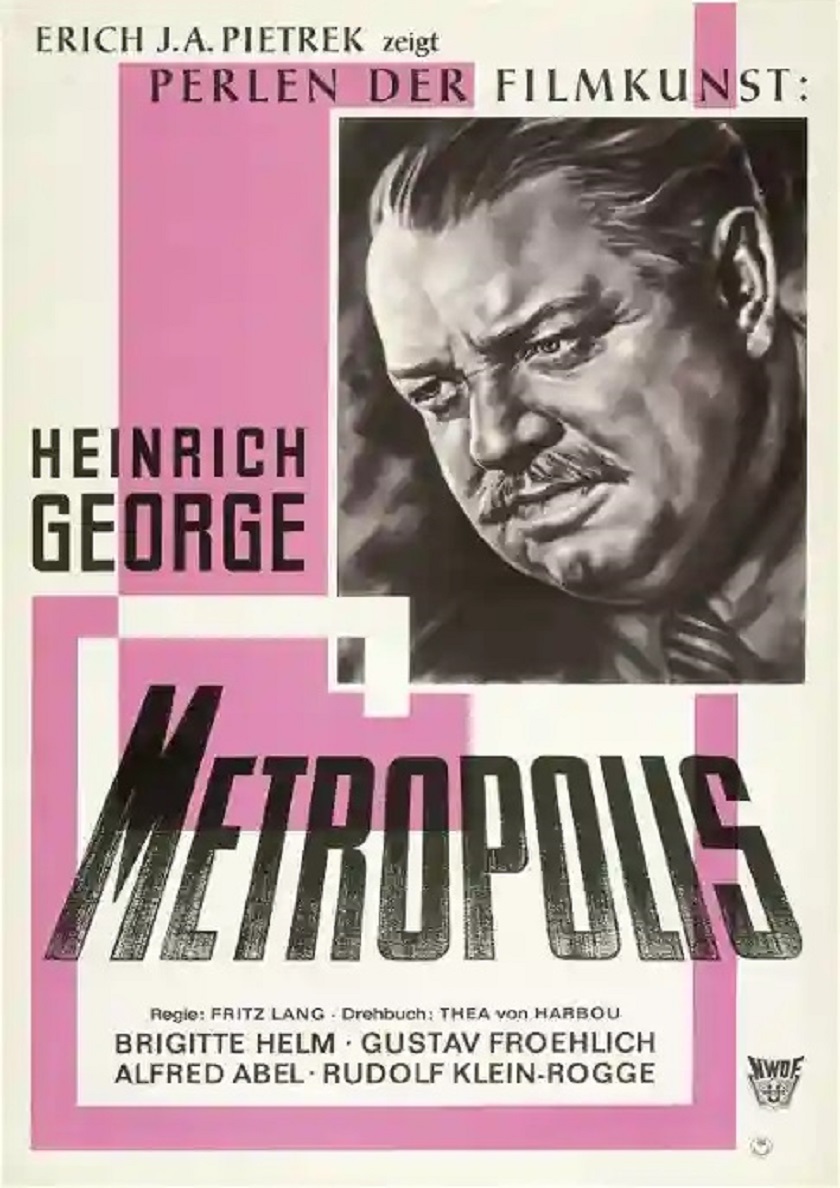 A1 poster, 59.4cm × 84.1cm, from March 1963 (from a Heinrich George retrospective) Artist: UNKNOWN |
|
Metropolis. The popularity of Der General was most likely
the inspiration for Nordwestdeutscher Filmverleih to issue the MoMA/BFI edition of
Metropolis, left side cropped off, carelessly printed.
Heinrich Riethmüller did the score,
bits and pieces of which he freely adapted from Gottfried Huppertz’s 1927 original.
|
|
Dr. Mabuse. Der General was such a monumental success, indeed, that
Erwin Leiser of Atlas Film
negotiated with Fritz Lang to reissue Dr. Mabuse, albeit abridged,
with a brilliant score by Konrad Elfers.
If you’ve not seen Dr. Mabuse,
get an
|
|
Die Zwanziger Jahre. Atlas also released that same year four movies with new music scores by
Peter
Schirmann:
Nosferatu,
The Last Laugh,
The Cabinet of Dr. Caligari, and
Destiny.
We can be certain, even without checking,
that the left side was lopped off and that the films were all misprinted.
Were they profitable?
How long did they play?
Where?
I would LOVE to find copies of all these.
Atlas once issued Schirmann’s edition of Nosferatu on VHS and Madacy later issued it on DVD.
What about the others?
|
|
filmkunstgrafik, Das Kabinett des Dr. Caligari - Trailer, posted on Mar 26, 2010 If YouTube ever disappears this video, download it. |
|
The poster for the 1964 edition of Destiny (Der müde Tod)?
I can’t find it anywhere. Sorry. |
|
The poster for the 1965 edition of Metropolis?
I can’t find it anywhere. Sorry. |
|
Metropolis redux. The following year, 1965, Nordwestdeutscher Filmverleih issued a slightly trimmed edition of its 1963 Metropolis,
this time with
a
|
|
The Legacy. When we now watch silent movies, often what we see unspool before our eyes are authentic copies,
properly presented with appropriate musical accompaniment.
We can thank Buster for that, for it was he who started that trend.
|
|
A few more, for fun:
|
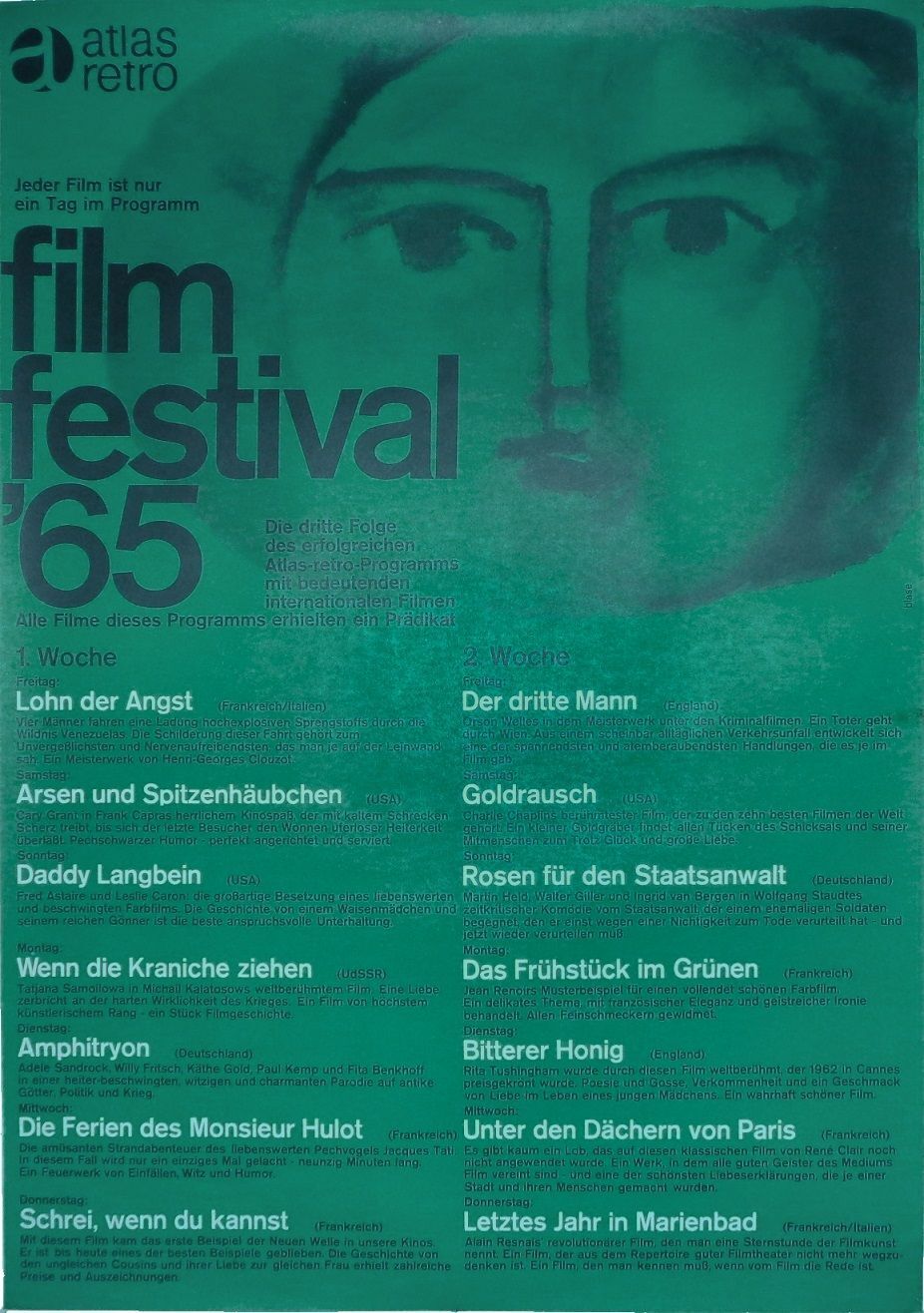
|